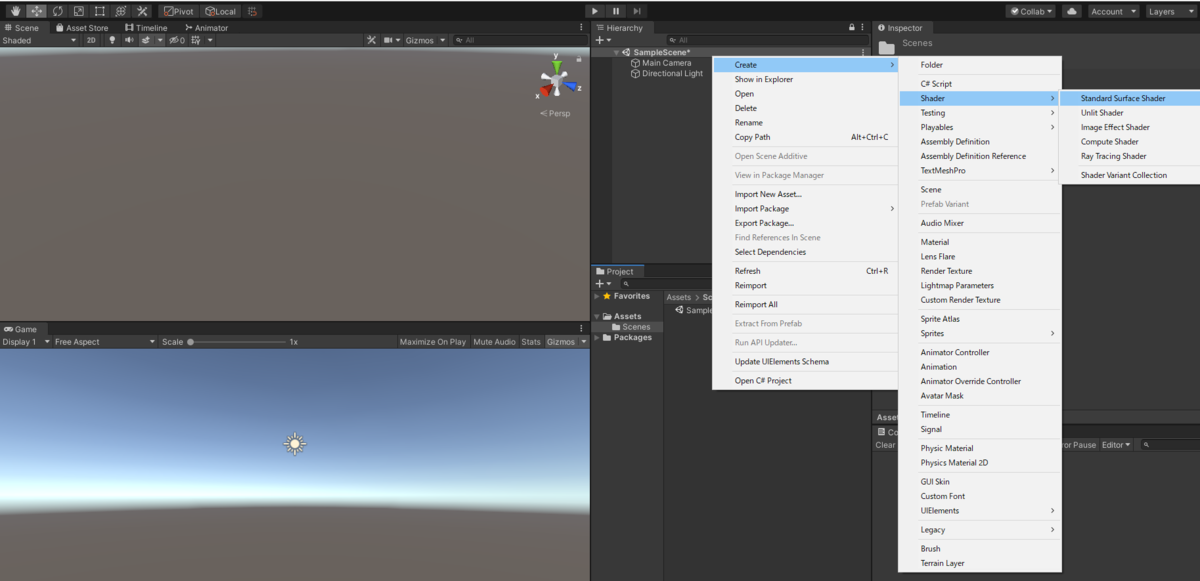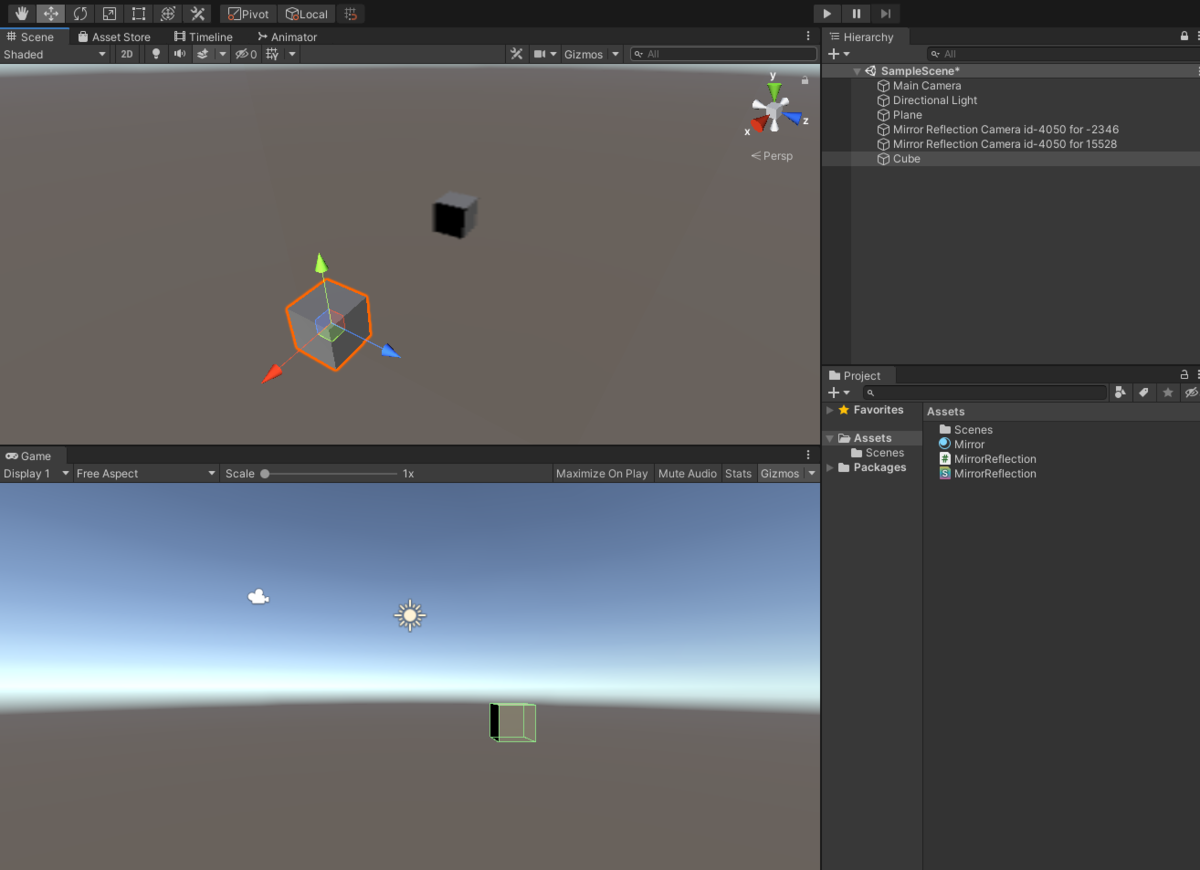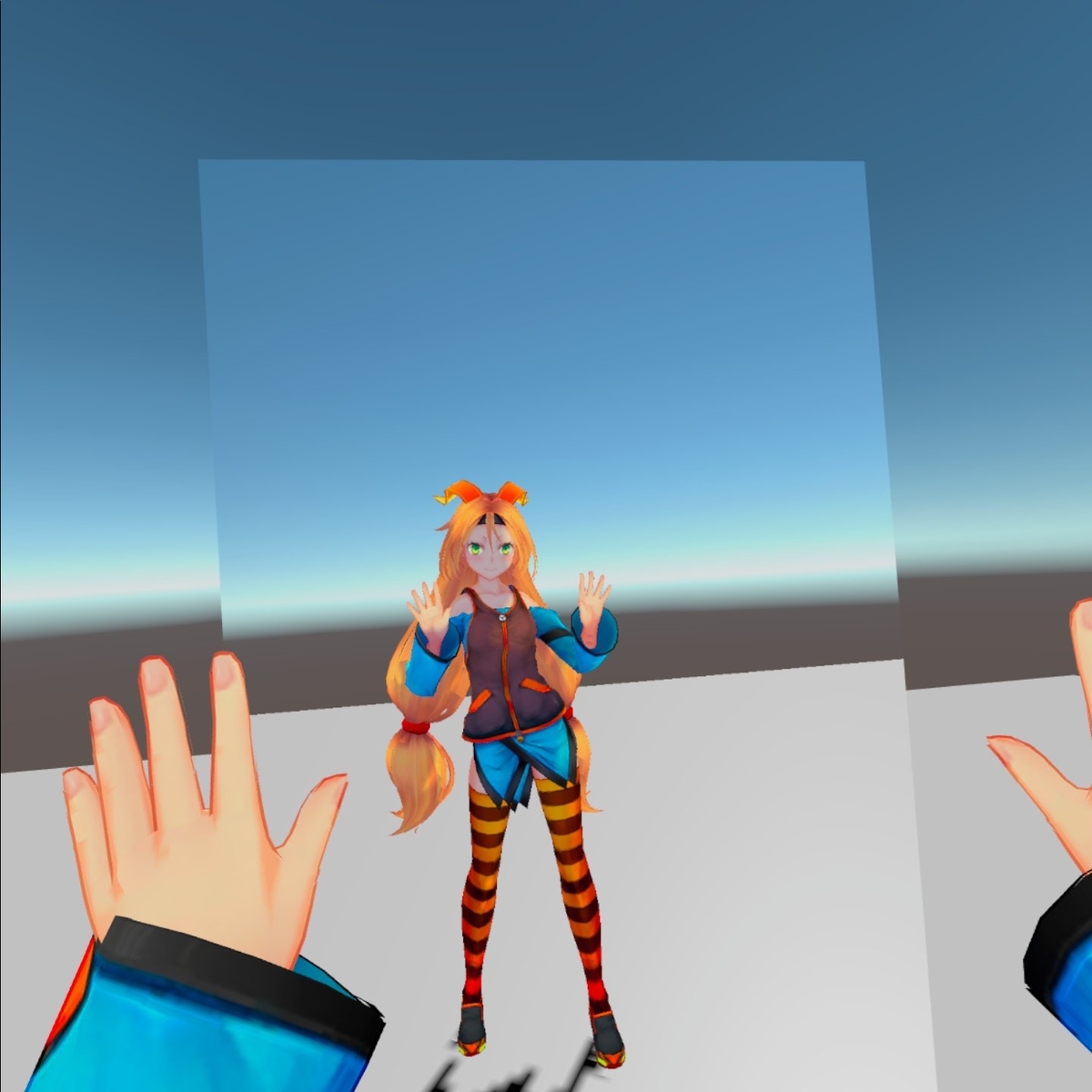VR用の鏡を実装する方法~oculusquest2~
はじめに
oculus quest2でVRでのキャラクターの操作を行いたかったため、
キャラが動いている様子を確認するための鏡を用意したかったのですが、
VRの鏡を実装している記事を見ていると
- SteamVR Plugin + Vive Stereo Rendering Toolkitを利用した鏡の実装
- VRChat SDK
- magic mirrorアセットの有料版
上記の方法で鏡を用意している方が多い印象でした。
ただこれらのやり方だとセットアップがあったり、unityのバージョンによって動かなかったり、
お金がかかったりするので、できる限りこれらを避けて鏡が実装できないものかといろんな記事を探しました。
そこで見つけたのが以下の記事
unity公式のフォーラムに鏡の実装方法について様々な投稿がされており、
その中でVR用の鏡の実装についての投稿もありました!
以下、VR用の鏡の実装方法を書いていきます。
今回の実行環境
・windows10
・unity 2019.4.13f1
・oculus quest2
VR用鏡の実装方法
フォーラムに載っていた鏡用のシェーダーとスクリプトを使用します。
以下、ソースコードです。
(CC BY-SA 3.0ライセンスでフォーラムから引用しています。)
Mirror.shader
// original source from: http://wiki.unity3d.com/index.php/MirrorReflection4
// taken from: https://forum.unity.com/threads/mirror-reflections-in-vr.416728/#post-3594431
Shader "FX/MirrorReflection"
{
Properties
{
_MainTex ("_MainTex", 2D) = "white" {}
_ReflectionTexLeft ("_ReflectionTexLeft", 2D) = "white" {}
_ReflectionTexRight ("_ReflectionTexRight", 2D) = "white" {}
}
SubShader
{
Tags { "RenderType"="Opaque" }
LOD 100
Pass {
CGPROGRAM
#pragma vertex vert
#pragma fragment frag
#include "UnityCG.cginc"
struct v2f
{
float2 uv : TEXCOORD0;
float4 refl : TEXCOORD1;
float4 pos : SV_POSITION;
};
float4 _MainTex_ST;
v2f vert(float4 pos : POSITION, float2 uv : TEXCOORD0)
{
v2f o;
o.pos = UnityObjectToClipPos (pos);
o.uv = TRANSFORM_TEX(uv, _MainTex);
o.refl = ComputeScreenPos (o.pos);
return o;
}
sampler2D _MainTex;
sampler2D _ReflectionTexLeft;
sampler2D _ReflectionTexRight;
fixed4 frag(v2f i) : SV_Target
{
fixed4 tex = tex2D(_MainTex, i.uv);
fixed4 refl;
if (unity_StereoEyeIndex == 0) refl = tex2Dproj(_ReflectionTexLeft, UNITY_PROJ_COORD(i.refl));
else refl = tex2Dproj(_ReflectionTexRight, UNITY_PROJ_COORD(i.refl));
return tex * refl;
}
ENDCG
}
}
}
MirrorReflection.cs
// original source from: http://wiki.unity3d.com/index.php/MirrorReflection4
// taken from: https://forum.unity.com/threads/mirror-reflections-in-vr.416728/#post-3691759
using UnityEngine;
using System.Collections;
using System.Collections.Generic;
using UnityEngine.XR;
// This is in fact just the Water script from Pro Standard Assets,
// just with refraction stuff removed.
[ExecuteInEditMode] // Make mirror live-update even when not in play mode
public class MirrorReflection : MonoBehaviour
{
public bool m_DisablePixelLights = true;
public int m_TextureSize = 256;
public float m_ClipPlaneOffset = 0.07f;
public int m_framesNeededToUpdate = 0;
public LayerMask m_ReflectLayers = -1;
private Dictionary<Camera, Camera> m_ReflectionCameras = new Dictionary<Camera, Camera>();
private RenderTexture m_ReflectionTextureLeft = null;
private RenderTexture m_ReflectionTextureRight = null;
private int m_OldReflectionTextureSize = 0;
private int m_frameCounter = 0;
private static bool s_InsideRendering = false;
// This is called when it's known that the object will be rendered by some
// camera. We render reflections and do other updates here.
// Because the script executes in edit mode, reflections for the scene view
// camera will just work!
public void OnWillRenderObject()
{
if (m_frameCounter > 0)
{
m_frameCounter--;
return;
}
var rend = GetComponent<Renderer>();
if (!enabled || !rend || !rend.sharedMaterial || !rend.enabled)
return;
Camera cam = Camera.current;
if (!cam)
return;
// Safeguard from recursive reflections.
if (s_InsideRendering)
return;
s_InsideRendering = true;
m_frameCounter = m_framesNeededToUpdate;
RenderCamera(cam, rend, Camera.StereoscopicEye.Left, ref m_ReflectionTextureLeft);
if (cam.stereoEnabled)
RenderCamera(cam, rend, Camera.StereoscopicEye.Right, ref m_ReflectionTextureRight);
}
private void RenderCamera(Camera cam, Renderer rend, Camera.StereoscopicEye eye, ref RenderTexture reflectionTexture)
{
Camera reflectionCamera;
CreateMirrorObjects(cam, eye, out reflectionCamera, ref reflectionTexture);
// find out the reflection plane: position and normal in world space
Vector3 pos = transform.position;
Vector3 normal = transform.up;
// Optionally disable pixel lights for reflection
int oldPixelLightCount = QualitySettings.pixelLightCount;
if (m_DisablePixelLights)
QualitySettings.pixelLightCount = 0;
CopyCameraProperties(cam, reflectionCamera);
// Render reflection
// Reflect camera around reflection plane
float d = -Vector3.Dot(normal, pos) - m_ClipPlaneOffset;
Vector4 reflectionPlane = new Vector4(normal.x, normal.y, normal.z, d);
Matrix4x4 reflection = Matrix4x4.zero;
CalculateReflectionMatrix(ref reflection, reflectionPlane);
Vector3 oldEyePos;
Matrix4x4 worldToCameraMatrix;
if (cam.stereoEnabled)
{
worldToCameraMatrix = cam.GetStereoViewMatrix(eye) * reflection;
Vector3 eyeOffset;
if (eye == Camera.StereoscopicEye.Left)
eyeOffset = InputTracking.GetLocalPosition(XRNode.LeftEye);
else
eyeOffset = InputTracking.GetLocalPosition(XRNode.RightEye);
eyeOffset.z = 0.0f;
oldEyePos = cam.transform.position + cam.transform.TransformVector(eyeOffset);
}
else
{
worldToCameraMatrix = cam.worldToCameraMatrix * reflection;
oldEyePos = cam.transform.position;
}
Vector3 newEyePos = reflection.MultiplyPoint(oldEyePos);
reflectionCamera.transform.position = newEyePos;
reflectionCamera.worldToCameraMatrix = worldToCameraMatrix;
// Setup oblique projection matrix so that near plane is our reflection
// plane. This way we clip everything below/above it for free.
Vector4 clipPlane = CameraSpacePlane(worldToCameraMatrix, pos, normal, 1.0f);
Matrix4x4 projectionMatrix;
//if (cam.stereoEnabled) projectionMatrix = HMDMatrix4x4ToMatrix4x4(cam.GetStereoProjectionMatrix(Camera.StereoscopicEye.Left));
//else
//if (cam.stereoEnabled)
// projectionMatrix = HMDMatrix4x4ToMatrix4x4(SteamVR.instance.hmd.GetProjectionMatrix((Valve.VR.EVREye)eye, cam.nearClipPlane, cam.farClipPlane));
//else
if (cam.stereoEnabled)
projectionMatrix = cam.GetStereoProjectionMatrix(eye);
else
projectionMatrix = cam.projectionMatrix;
//projectionMatrix = cam.CalculateObliqueMatrix(clipPlane);
MakeProjectionMatrixOblique(ref projectionMatrix, clipPlane);
reflectionCamera.projectionMatrix = projectionMatrix;
reflectionCamera.cullingMask = m_ReflectLayers.value;
reflectionCamera.targetTexture = reflectionTexture;
GL.invertCulling = true;
//Vector3 euler = cam.transform.eulerAngles;
//reflectionCamera.transform.eulerAngles = new Vector3(0, euler.y, euler.z);
reflectionCamera.transform.rotation = cam.transform.rotation;
reflectionCamera.Render();
//reflectionCamera.transform.position = oldEyePos;
GL.invertCulling = false;
Material[] materials = rend.sharedMaterials;
string property = "_ReflectionTex" + eye.ToString();
foreach (Material mat in materials)
{
if (mat.HasProperty(property))
mat.SetTexture(property, reflectionTexture);
}
// Restore pixel light count
if (m_DisablePixelLights)
QualitySettings.pixelLightCount = oldPixelLightCount;
s_InsideRendering = false;
}
// Cleanup all the objects we possibly have created
void OnDisable()
{
if (m_ReflectionTextureLeft)
{
DestroyImmediate(m_ReflectionTextureLeft);
m_ReflectionTextureLeft = null;
}
if (m_ReflectionTextureRight)
{
DestroyImmediate(m_ReflectionTextureRight);
m_ReflectionTextureRight = null;
}
foreach (var kvp in m_ReflectionCameras)
DestroyImmediate(((Camera)kvp.Value).gameObject);
m_ReflectionCameras.Clear();
}
private void CopyCameraProperties(Camera src, Camera dest)
{
if (dest == null)
return;
// set camera to clear the same way as current camera
dest.clearFlags = src.clearFlags;
dest.backgroundColor = src.backgroundColor;
if (src.clearFlags == CameraClearFlags.Skybox)
{
Skybox sky = src.GetComponent(typeof(Skybox)) as Skybox;
Skybox mysky = dest.GetComponent(typeof(Skybox)) as Skybox;
if (!sky || !sky.material)
{
mysky.enabled = false;
}
else
{
mysky.enabled = true;
mysky.material = sky.material;
}
}
// update other values to match current camera.
// even if we are supplying custom camera&projection matrices,
// some of values are used elsewhere (e.g. skybox uses far plane)
dest.farClipPlane = src.farClipPlane;
dest.nearClipPlane = src.nearClipPlane;
dest.orthographic = src.orthographic;
dest.fieldOfView = src.fieldOfView;
dest.aspect = src.aspect;
dest.orthographicSize = src.orthographicSize;
}
// On-demand create any objects we need
private void CreateMirrorObjects(Camera currentCamera, Camera.StereoscopicEye eye, out Camera reflectionCamera, ref RenderTexture reflectionTexture)
{
reflectionCamera = null;
// Reflection render texture
if (!reflectionTexture || m_OldReflectionTextureSize != m_TextureSize)
{
if (reflectionTexture)
DestroyImmediate(reflectionTexture);
reflectionTexture = new RenderTexture(m_TextureSize, m_TextureSize, 16);
reflectionTexture.name = "__MirrorReflection" + eye.ToString() + GetInstanceID();
reflectionTexture.isPowerOfTwo = true;
reflectionTexture.hideFlags = HideFlags.DontSave;
m_OldReflectionTextureSize = m_TextureSize;
}
// Camera for reflection
if (!m_ReflectionCameras.TryGetValue(currentCamera, out reflectionCamera)) // catch both not-in-dictionary and in-dictionary-but-deleted-GO
{
GameObject go = new GameObject("Mirror Reflection Camera id" + GetInstanceID() + " for " + currentCamera.GetInstanceID(), typeof(Camera), typeof(Skybox));
reflectionCamera = go.GetComponent<Camera>();
reflectionCamera.enabled = false;
reflectionCamera.transform.position = transform.position;
reflectionCamera.transform.rotation = transform.rotation;
reflectionCamera.gameObject.AddComponent<FlareLayer>();
go.hideFlags = HideFlags.DontSave;
m_ReflectionCameras.Add(currentCamera, reflectionCamera);
}
}
// Extended sign: returns -1, 0 or 1 based on sign of a
private static float sgn(float a)
{
if (a > 0.0f) return 1.0f;
if (a < 0.0f) return -1.0f;
return 0.0f;
}
// Given position/normal of the plane, calculates plane in camera space.
private Vector4 CameraSpacePlane(Matrix4x4 worldToCameraMatrix, Vector3 pos, Vector3 normal, float sideSign)
{
Vector3 offsetPos = pos + normal * m_ClipPlaneOffset;
Vector3 cpos = worldToCameraMatrix.MultiplyPoint(offsetPos);
Vector3 cnormal = worldToCameraMatrix.MultiplyVector(normal).normalized * sideSign;
return new Vector4(cnormal.x, cnormal.y, cnormal.z, -Vector3.Dot(cpos, cnormal));
}
// Calculates reflection matrix around the given plane
private static void CalculateReflectionMatrix(ref Matrix4x4 reflectionMat, Vector4 plane)
{
reflectionMat.m00 = (1F - 2F * plane[0] * plane[0]);
reflectionMat.m01 = (-2F * plane[0] * plane[1]);
reflectionMat.m02 = (-2F * plane[0] * plane[2]);
reflectionMat.m03 = (-2F * plane[3] * plane[0]);
reflectionMat.m10 = (-2F * plane[1] * plane[0]);
reflectionMat.m11 = (1F - 2F * plane[1] * plane[1]);
reflectionMat.m12 = (-2F * plane[1] * plane[2]);
reflectionMat.m13 = (-2F * plane[3] * plane[1]);
reflectionMat.m20 = (-2F * plane[2] * plane[0]);
reflectionMat.m21 = (-2F * plane[2] * plane[1]);
reflectionMat.m22 = (1F - 2F * plane[2] * plane[2]);
reflectionMat.m23 = (-2F * plane[3] * plane[2]);
reflectionMat.m30 = 0F;
reflectionMat.m31 = 0F;
reflectionMat.m32 = 0F;
reflectionMat.m33 = 1F;
}
// taken from http://www.terathon.com/code/oblique.html
private static void MakeProjectionMatrixOblique(ref Matrix4x4 matrix, Vector4 clipPlane)
{
Vector4 q;
// Calculate the clip-space corner point opposite the clipping plane
// as (sgn(clipPlane.x), sgn(clipPlane.y), 1, 1) and
// transform it into camera space by multiplying it
// by the inverse of the projection matrix
q.x = (sgn(clipPlane.x) + matrix[8]) / matrix[0];
q.y = (sgn(clipPlane.y) + matrix[9]) / matrix[5];
q.z = -1.0F;
q.w = (1.0F + matrix[10]) / matrix[14];
// Calculate the scaled plane vector
Vector4 c = clipPlane * (2.0F / Vector3.Dot(clipPlane, q));
// Replace the third row of the projection matrix
matrix[2] = c.x;
matrix[6] = c.y;
matrix[10] = c.z + 1.0F;
matrix[14] = c.w;
}
}
①まずはシェーダーとスクリプトをそれぞれ用意します。
シェーダーについては詳しくないのですが、
Standard Surface Shaderで作成して問題ないと思います。

②シェーダーを適用させるマテリアルを用意し、シェーダーを適用します。
③鏡にするオブジェクトを用意する。
この時のオブジェクトはPlaneにしてください。
Plane以外では正しく動作しない?かもしれません。
RotationをX:0,Y:0,Z:-90としてください。
④オブジェクトにシェーダーを適用させたマテリアルとスクリプトをアタッチします。
スクリプトをアタッチしたときにMirror Reflection Camera id-○○ for -○○
が生成されますがこれはそのままにしてください。
消してもunity実行時に再生成されます。
⑤鏡に映したいオブジェクトを配置し、鏡ができていることを確認する。

これで鏡を置くことができます。
鏡の映りが粗い場合はアタッチしたスクリプトのコンポーネントの
Texture Sizeの値を大きくしていくと映りが良くなっていきます。
1000くらいでunityエディタ上ではきれいに映りますが、VR越しだと2000くらい必要になりそうです。
この値が大きくなるほど描画の処理が重くなるので気を付けましょう。
以下はunityちゃんのキャラ操作を行っているときのものです。
